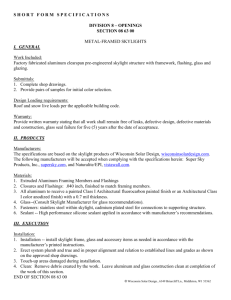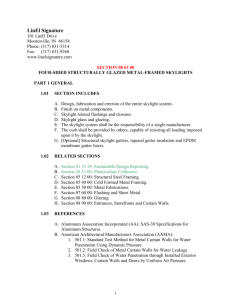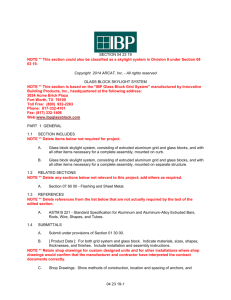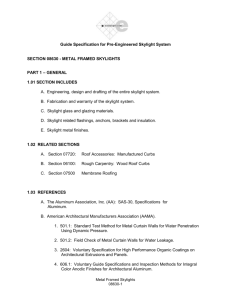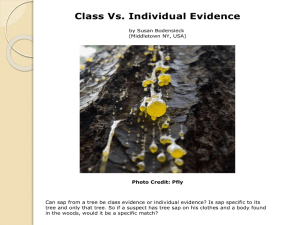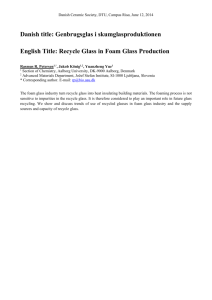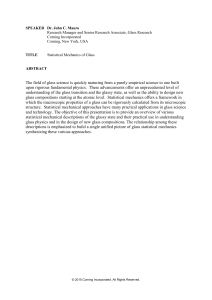DIVISION 13 - SPECIAL CONSTRUCTION
advertisement
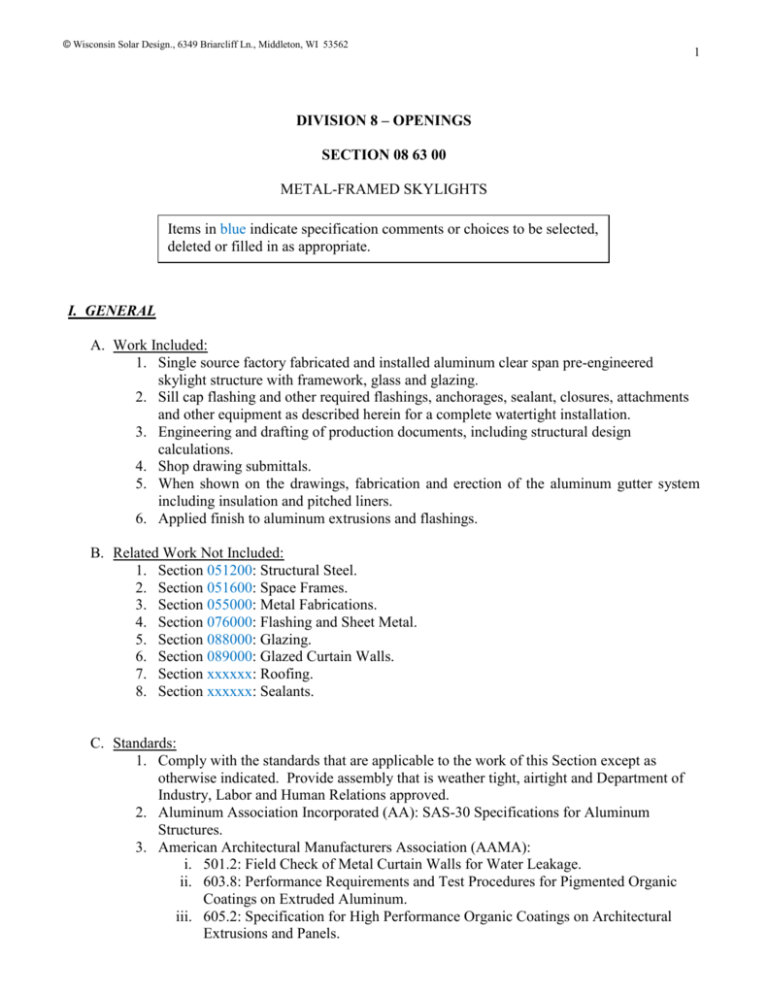
© Wisconsin Solar Design., 6349 Briarcliff Ln., Middleton, WI 53562 1 DIVISION 8 – OPENINGS SECTION 08 63 00 METAL-FRAMED SKYLIGHTS Items in blue indicate specification comments or choices to be selected, deleted or filled in as appropriate. I. GENERAL A. Work Included: 1. Single source factory fabricated and installed aluminum clear span pre-engineered skylight structure with framework, glass and glazing. 2. Sill cap flashing and other required flashings, anchorages, sealant, closures, attachments and other equipment as described herein for a complete watertight installation. 3. Engineering and drafting of production documents, including structural design calculations. 4. Shop drawing submittals. 5. When shown on the drawings, fabrication and erection of the aluminum gutter system including insulation and pitched liners. 6. Applied finish to aluminum extrusions and flashings. B. Related Work Not Included: 1. Section 051200: Structural Steel. 2. Section 051600: Space Frames. 3. Section 055000: Metal Fabrications. 4. Section 076000: Flashing and Sheet Metal. 5. Section 088000: Glazing. 6. Section 089000: Glazed Curtain Walls. 7. Section xxxxxx: Roofing. 8. Section xxxxxx: Sealants. C. Standards: 1. Comply with the standards that are applicable to the work of this Section except as otherwise indicated. Provide assembly that is weather tight, airtight and Department of Industry, Labor and Human Relations approved. 2. Aluminum Association Incorporated (AA): SAS-30 Specifications for Aluminum Structures. 3. American Architectural Manufacturers Association (AAMA): i. 501.2: Field Check of Metal Curtain Walls for Water Leakage. ii. 603.8: Performance Requirements and Test Procedures for Pigmented Organic Coatings on Extruded Aluminum. iii. 605.2: Specification for High Performance Organic Coatings on Architectural Extrusions and Panels. 2 4. 5. 6. 7. 8. iv. 606.1: Voluntary Guide Specification and Inspection Methods for Integral Color Anodic Finishes for Architectural Aluminum. v. 607.1: Voluntary Guide Specification and Inspection Methods for Clear Anodic Finishes for Architectural Aluminum. vi. 1503-09, Voluntary Test Method for Thermal Transmittance and Condensation Resistance of Windows, Doors and Glazed Wall Sections. American National Standards Institute (ANSI): Z 97.1 -1984- Safety Glazing Materials Used in Buildings -Safety Performance Specifications and Methods of Test. American Society for Testing and Materials (ASTM): i. A193: Standard Specification for Alloy-Steel and Stainless Steel Bolting Materials for High Temperature Service. ii. A307: Specification for Carbon Steel Bolts and Studs, 60,000 psi Tensile Strength. iii. B209: Specification for Aluminum and Aluminum-Alloy Sheet and Plate. iv. B211: Specification for Aluminum-Alloy Bar, Rod and Wire. v. B221: Specification for Aluminum and Aluminum-Alloy Extruded Bars, Rods, Wire, Shapes and Tubes. vi. B316: Specification for Aluminum and Aluminum-Alloy Rivet and Cold-Heading Wire and Rods. vii. C719: Standard Test Method for Adhesion and Cohesion of Elastomeric Joint Sealants Under Cycle Movement. viii. C794: Test Method for Adhesion-In-Peel of Elastomeric Joint Sealants. ix. C1036: Specification for Flat Glass. x. C1048: Specification for Heat-Treated Flat Glass-Kind HS, Kind FT Coated and Uncoated Glass. xi. D395: Test Methods for Rubber Property -Compression Set. xii. D412: Test Methods for Rubber Properties in Tension. xiii. D1171: Test Method for Rubber Deterioration -Surface Ozone Cracking Outdoors or Chamber (Triangular Specimens). xiv. D2240: Test Method for Rubber Property -Durometer Hardness. xv. E283: Test Method for Rate of Air Leakage Through Exterior Windows, Curtain Walls, and Doors. xvi. E330: Test Method for Structural Performance of Exterior Windows, Curtain Walls and Doors by Uniform Static Air Pressure Difference. xvii. E331: Standard Test Method for Water Penetration of Exterior Windows, Curtain Walls and Doors by Uniform Static Air Pressure Difference. xviii. E773: Test Method for Seal Durability of Sealed Insulating Glass Units. xix. E774: Specification for Sealed Insulating Glass Units. Consumer Product Safety Commission (CPSC): 16CFR 1202 - Architectural Glazing Standards and Related Material. Flat Glass Manufacturers Association (FGMA): Glazing Manual. Insulating Glass Certification Council (IGCC): Classification of Insulating Glass Units. D. Submittals: 1. Prior to starting fabrication, submit manufacturers’ product specifications, test results showing compliance with performance criteria described below, complete shop drawings, handling installation and protection instructions. Indicate pertinent dimensioning, general construction, component connections and locations, anchorage methods, locations and installation details. 3 2. Provide pairs of samples for initial color selection on 12” long sections of extrusions or formed shapes. Where normal color variations are anticipated, include two or more units in each set indicating limits of color variations. 3. Submit structural calculations prepared in accordance with the Aluminum Association's Specifications for Aluminum Structures (SAS30) by a structural engineer qualified in the design of self-supporting sloped glazed systems and licensed to practice in the state where the skylight is manufactured. 4. Submit if specifically requested: i. Submit (2) 12-in. x 12-in. samples of each type of glass. ii. Submit (2) manufacturer's samples of each type of sealant. iii. Submit (2) 6-in. long samples of extrusions (with appropriate finish). iv. Submit (3) sets of as-built drawings and cleaning and maintenance manuals. v. Certification that insulating glass units will withstand specified design loads. E. Quality Assurance: 1. The skylight installers shall be permanent full-time employees of the skylight manufacturer. 2. Engage a single source manufacturer/installer for the metal-framed skylights. Skylight source will assume undivided responsibility for all components, including structural design, engineering, fabrication, finishing, preparation at the job site, erection and glazing of the skylight system and the weatherproof integrity of the system in place. 3. The manufacturer shall be able to demonstrate that it has performed successfully on comparably sized projects and of comparable design complexity for ten years. 4. Comply with recommendations of Flat Glass Marketing Association (FGMA) “Glazing Manual” and “Sealant Manual” except where more stringent requirements are indicated. Refer to those publications for definitions of glass and glazing terms not otherwise defined in this Section or referenced standards. F. Design Loading requirements: 1. Design loads: as prescribed by governing building codes. 2. Concentrated load of 250lb applied to any framing member at a location that will produce the most severe stress or deflection. 3. American National Standard “Minimum Design Loads for Buildings and Other Structures” ANSI A58.1 -- latest edition. 4. Design assembly to safely carry all dead, snow, wind, thermal and building movement loads, as well as any additional service and construction loads. 5. The deflection of a framing member in a direction parallel to the plane of glass, when carrying its full dead load, shall not exceed an amount which will reduce the glass or panel bite below 75% of the design dimension and the member shall have a 1/8-in. minimum clearance between itself and the edge of the fixed panel, glass, or component immediately adjacent, nor shall it impair the function of or damage any joint seals. 6. Deflection of members shall not exceed design span divided by 175 (L/175) or one (1) inch for clear spans under 20-ft., or L/240 for clear spans greater than 20-ft. G. Performance: 1. When tested in accordance with AAMA 1503-09/NFRC 100/ASTM C 1199/ ASTM E 1423: i. The thermal performance Condensation Resistance Factor (CRF) of the skylight frame shall be 70 or higher. ii. The U factor of the skylight frame shall be 0.23 or lower. 4 2. 3. 4. 5. 6. 7. 8. 9. iii. The skylight system shall be certified and labeled according to NFRC. When tested in accordance with ASTM E-283, air infiltration shall not exceed .06 cfm/sf of fixed area at a test pressure of 6.24 psf. When tested in accordance with ASTM E-331, there shall be no uncontrolled water penetration at a test pressure of 12.0 psf. The system shall perform to these criteria under a combined load as dictated by the state building codes for dead load and live load. Thermal Movement: Provide for such expansion and contraction of component materials as will be caused by the ambient surface temperature range without buckling, stress on glass, failure of seals, undue stress on structural elements, reduction of performance or other detrimental effects. Where permitted by code, a 1/3 increase in allowable stress for wind or seismic load shall be acceptable, but not in combination with any reduction applied to combined loads. In no case shall allowable values exceed the yield stress. Compression flanges of flexural members may be assumed to receive effective lateral bracing only from anchors to the building structure and horizontal glazing bars or interior trim which are in contact with 50% of the member's total depth. The skylight framing is designed to be self-supporting between the supporting construction. The skylights will impose reactions to the support construction. All adjacent and support construction must support the transfer of all loads including horizontal and vertical, exerted by the skylights. Design or structural engineering services for the supporting structure or building components not included in the skylight scope are not included under this section. Limited reaction design “LRD”: [If this item is to be included, delete the item immediately above. Alternatively, if this item will not be included, delete it.] The skylight framing is to be designed to exert no horizontal reactions under vertical gravity type loads, (dead, snow, live). Unbalanced live loads, (wind, seismic, etc.), acting upon the skylight will produce horizontal reactions that cannot be controlled by the skylights, but must be resisted by the support structure. H. Coordination: 1. Coordinate skylight work with the adjoining work of other trades. 2. Verify field curb dimensions when available. 3. Obtain “guaranteed dimensions” when obtaining actual field measurements will delay job progress. I. Warranty: 1. Warranty period will be [choose one: two (2), five (5), ten (10), twenty (20)] years after the date of substantial completion. 2. Provide a written warranty from the skylight manufacturer stating that all work of this Section will remain free from defects including: i. water leakage, defective design, defective materials and construction. ii. glass seal failure, delamination, discoloration and defects in manufacture. iii. harmonic vibration, wind whistles, noises caused by thermal movement, loosening, weakening or fracturing attachments to other adjacent components. iv. deterioration of finishes including checking, fading, peeling, crazing and chalking beyond normal weathering. II. PRODUCTS A. Manufacturers: 5 1. The specifications are based on the skylight products of Wisconsin Solar Design, Inc., www.wisconsinsolardesign.com. 2. [Complete or delete this item.] Acceptable manufacturers: i. [Manufacturer #2] ii. [Manufacturer #3] 3. Other manufacturers may bid this project provided they comply with all of the performance requirements of this specification and pre-qualify with the Architect per section 016000 Product Requirements, [optional, specify how many days, i.e., no less than # days] prior to bid date. B. Materials: 1. Extruded Aluminum Framing Members: ASTM B221 Alloy G.S. 10A-T6, 6063-T6 alloy and temper. 2. Structural members: 0.125” thick minimum. 3. Extruded caps, closures and miscellaneous trim: 0.060” thick minimum. 4. Aluminum sheet for Closures and Flashings: ASTM B209-86 3003-H14 with a minimum thickness of .040 inch, finished to match framing members. 5. Sheet metal flashings/closures/claddings are to be furnished shop formed to profile in min. 10-ft. lengths. When lengths exceed 10-ft., field trimming of the flashing and field forming the ends is necessary to suit as-built conditions. Sheet metal ends are to overlap 6-in. to 8-in. minimum, set in a full bed of sealant and riveted if required. 6. All aluminum to receive a factory applied [choose one: AAMA 2603-compliant, AAMA 2604-compliant, AAMA 2605-compliant] high performance oven baked two-step [optional: with clear topcoat] fluoropolymer [insert color here; full array of standard, premium, and custom colors available; reference Valdspar Fluropon and PPG Duranar lines for some options] painted finish or an Architectural Class I color anodized finish [insert color here; standard colors are clear, champagne, light bronze, medium bronze, dark bronze, extra dark bronze, black; other colors available] with a 0.7 mil minimum film thickness, conforming to Aluminum Association Standard AA-M21C22A42/A44 and AAMA 606.1 or AAMA 608.1. 7. [Glass--consult skylight manufacturer for glass recommendations. Almost limitless glass options are available. The make-up for skylight glass often placed in section 088000, Glass and Glazing, and may be referenced here as follows: For glass composition, see glass schedule in Section 088000 - Glass and Glazing. Wisconsin Solar Design Inc. lists below one possible glass selection using Solarban 70XL or Guardian SunGuard SNX 62/27, both which have LSG values of 2.3, as follows:] [X. Solar Control Low-E Insulating-Glass Units for Skylights and Sloped Glazing 1. Overall Unit Thickness: 1¼”. 2. Interspace Content: Air. 3. Outdoor Lite: Class 1 (clear) float glass, 6 mm minimum thickness. a. Kind FT fully tempered b. Solar Control Low-E Coating, PPG Industries, Inc., Solarban 70XL or equal, sputtered on second surface. 4. Indoor Lite: Laminated glass unit: Kind LHS: Two lites of heat-strengthened float glass a. Laminated Lite Outer Ply: Class 1 clear float glass. i. Thickness: 5.0 mm (6.0mm for larger units) b. Laminated Lite Plastic Interlayer: i. Thickness: 0.030 inch. (0.060 inch) ii. Interlayer Color: Clear. c. Laminated Lite Inner Ply: Class 1 clear float glass. i. Thickness: 5.0 mm. (6.0mm)] 6 8. Fasteners: ASTM B221 2024-T4 aluminum or 300 series stainless steel with integral color coating to match finish of aluminum where exposed to view; cadmium plated steel for connections to supporting structure. 9. Glazing gaskets -- manufacturer’s standard. 10. Setting blocks -- extruded Type II silicone rubber, manufacturer’s standard. 11. Sealant -- High performance silicone sealant applied in accordance with manufacturer’s recommendations. III. EXECUTION A. Delivery: 1. Deliver fabricated units and component parts to the jobsite completely identified with labels corresponding to the erection drawings. Protect surfaces from damage during shipping. Inspect materials for damage upon delivery to the jobsite. Touch-up or replace items with minor defects or scratches with the appropriate material. B. Pre-installation: 2. The furnishing of temporary covering, weatherproofing and protection of the skylight area before and after the skylight installation are excluded from the work of this section. C. Installation: 1. Manufacturer shall be totally responsible for the complete erection and glazing of the skylight installation. 2. Prior to the installation of the skylight system, arrange for the representative of the skylight manufacturer to examine the structure and substrate to determine that they are properly prepared, sized and ready to receive the skylight work specified herein. 3. Assist general contractor to coordinate installation with adjacent work such as roofing, sheet metal and other work to ensure a complete weatherproof assembly. 4. Contact between aluminum and dissimilar metals shall receive a protective coating at asphalt paint for the prevention of electrolytic action and corrosion. 5. Install skylight frame, glass and accessory items as needed in accordance with the manufacturer’s printed instructions matching profiles, sizes and spacing indicated on approved shop drawings. 6. During installation, remove labels, part number markings, sealant smears, handprints, and construction dirt from all components. Touch-up damaged coatings and finishes and repair minor damage to eliminate all evidence of repair. Remove and replace work that cannot be satisfactorily repaired. 7. Anchor work securely to supporting structure, but allow for differential and thermal movement. 8. Erect system plumb and true and in proper alignment and relation to established lines and grades as shown on the approved shop drawings. 9. Handle glass in accordance with the recommendations of the FNMA, latest edition. Use rubber spacers to maintain separation of glass and adjacent metal framework. 10. Touch-up areas damaged during installation. 11. Locate weep holes in sill to positively drain condensation to exterior of skylight at each rafter connection. 12. Sealants to be installed per sealant manufacturers’ instructions. Do not perform structural silicone sealant work when the metal temperature is below that recommended by the sealant manufacturer. 13. Before application, remove mortar dirt, dust moisture and other foreign matter from surfaces sealant will contact. Apply sealant in a tooled and uniform manner to completely fill joint. Remove excess sealant to leave uniform smooth edge. 7 D. Site Tolerances: 1. All supporting and adjacent construction will be held to within + ½” of theoretical. 2. Tolerances for the installation of related products: Refer to the sections noted in the “Related Work Not Included” paragraph above for specified tolerances for adjoining construction. E. Water Test: [Wisconsin Solar Design recommends considering field testing an option to be used on projects with larger or complex skylights and for occasions when normal exposure to weather and product guarantee do not provide adequate assurance of serviceability. Alternatively, delegate the hiring of the testing agency to the Owner. Delete Section ‘E’ entirely if field water testing is deemed to be unnecessary.] 1. [Optional: Owner may] Engage a certified testing agency to provide field hose testing in accordance with AAMA 501.2. 2. Tests will be conducted as soon as possible after the skylights are installed while allowing time for wet applied sealants to cure. 3. In the event that leakage is detected, the skylight is to be made watertight by the skylight manufacturer and subsequently retested by the testing agency. 4. Testing agency provides i. Calibrated Type B-25 #6.030 brass nozzle ii. All materials and labor necessary for testing. iii. One test technician and one assistant, gauges and instrumentation for conducting the testing. iv. A detailed report in electronic format (PDF) summarizing the results of the field tests. v. Insurance. 5. General contractor provides [coordinate these GC requirements with project requirements noted elsewhere] i. Source of water capable of delivering 30 to 35 psi to the nozzle. ii. 110/120 volt power supply within 100 feet of test area. iii. Access to the interior and exterior of the test area including any lifts and/or scaffolding as may be necessary. iv. Repair of any damage which may result from testing. v. [If Owner is providing the testing] Advance notification of testing schedule to allow skylight manufacturer to attend during testing. F. Cleaning: 1. Remove any temporary skylight coverings and protection of adjacent work areas at the completion of skylight installation. Repair or replace damaged installed products. Clean installed products in accordance with manufacturer's instructions prior to owner's acceptance. Remove construction debris from project site and legally dispose of debris. 2. The skylight subcontractor is required to leave glass and metal surfaces clean at the conclusion of the installation. Final cleaning is to be performed by the general contractor, not the skylight subcontractor, just prior to acceptance of the project by the owner. G. Protection: 1. Following conclusion of the installation by the skylight subcontractor, protection of the finished work shall become the responsibility of the general contractor. 8 END OF SECTION 08 63 00
